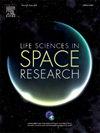Galactic cosmic ray environment predictions for the NASA BioSentinel Mission, part 2:Post-mission validation
IF 2.8
3区 生物学
Q2 ASTRONOMY & ASTROPHYSICS
引用次数: 0
Abstract
The BioSentinel CubeSat was deployed on the Artemis-I mission in November 2022 and has been continuously transmitting physical measurements of the space radiation environment since that time. Just before mission launch, we published computational model predictions of the galactic cosmic ray exposure expected inside BioSentinel for multiple locations and configurations. The predictions utilized models for the ambient galactic cosmic ray environment, radiation physics and transport, and BioSentinel geometry. Now that the nominal six-month BioSentinel mission has completed and some additional time has passed, those pre-launch predictions and additional model components can be validated. Dose-rate and linear energy transfer (LET) spectral measurements from the on-board dosimeter are presented along with a summary of the computational models used to calculate exposure quantities of interest. Sensitivity tests are performed to gauge the impact of various model choices on these quantities. Satellite data collected during the BioSentinel mission are used to provide some measure of independent validation for the galactic cosmic ray model used in the present calculations. It is shown that the combined models are in excellent agreement with the measured dose-rate. Model calculations agree well with measurement below ∼10 keV/µm and underpredict at higher LET. It is argued that the underprediction is likely due to detector response or low energy anomalous cosmic ray contributions able to reach the thinly shielded side of the on-board dosimeter.
NASA 生物哨兵任务的银河宇宙射线环境预测,第 2 部分:任务后验证。
“生物哨兵”立方体卫星于2022年11月在“青蒿1号”任务中部署,此后一直在持续传输空间辐射环境的物理测量数据。就在任务启动之前,我们发布了计算模型,预测了生物哨兵在多个位置和配置下预期的银河宇宙射线暴露。这些预测利用了银河系宇宙射线环境、辐射物理和传输以及生物哨兵几何模型。现在,名义上为期六个月的生物哨兵任务已经完成,并且已经过去了一些额外的时间,这些发射前的预测和额外的模型组件可以得到验证。介绍了机载剂量计的剂量率和线性能量传递(LET)光谱测量结果,以及用于计算感兴趣的暴露量的计算模型的摘要。进行敏感性测试以衡量各种模型选择对这些数量的影响。在生物哨兵任务期间收集的卫星数据被用来为目前计算中使用的银河宇宙射线模型提供一些独立验证的措施。结果表明,组合模型与测量的剂量率非常吻合。模型计算与低于~ 10 keV/µm的测量结果吻合良好,但对较高LET值的预测不足。有人认为,预估不足可能是由于探测器响应或低能异常宇宙射线贡献能够到达板载剂量计的薄屏蔽侧。
本文章由计算机程序翻译,如有差异,请以英文原文为准。
求助全文
约1分钟内获得全文
求助全文
来源期刊

Life Sciences in Space Research
Agricultural and Biological Sciences-Agricultural and Biological Sciences (miscellaneous)
CiteScore
5.30
自引率
8.00%
发文量
69
期刊介绍:
Life Sciences in Space Research publishes high quality original research and review articles in areas previously covered by the Life Sciences section of COSPAR''s other society journal Advances in Space Research.
Life Sciences in Space Research features an editorial team of top scientists in the space radiation field and guarantees a fast turnaround time from submission to editorial decision.
 求助内容:
求助内容: 应助结果提醒方式:
应助结果提醒方式:


